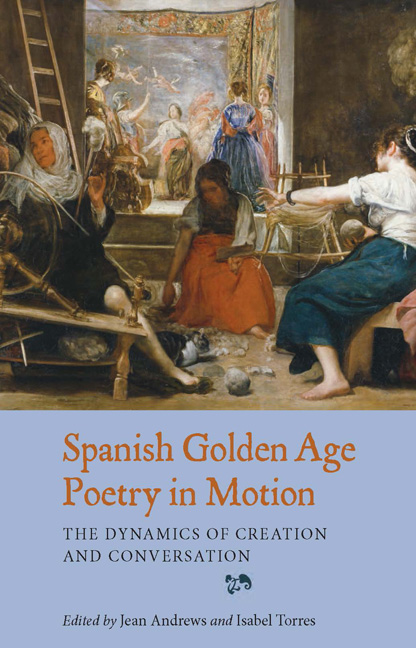Book contents
- Frontmatter
- Contents
- Contributors
- Acknowledgements
- Introduction
- 1 La poesía mutante del Siglo de Oro
- Part 1 Poetry in Creation
- 2 Moving in …Garcilaso de la Vega's ‘Dulces prendas por mi mal halladas’
- 3 The Movement of Thought and Feeling in the ‘Ode to Juan de Grial’
- 4 Metaphors of Movement in Two Poems of Fray Luis de León
- 5 El tiempo medido en versos: Camila Lucinda en las Rimas (1609) de Lope de Vega
- 6 Upwards to Helicon: Lope de Vega, the Laurel de Apolo, and Acts of Judgement
- 7 ‘Dulce es refugio’: El peregrino de Góngora se detiene
- 8 The Staging of Góngora's Three Funereal Sonnets for Margarita de Austria Estiria
- 9 Jealousy in María de Zayas's Intercalated Poetry: Lyric Illness and Narrative Cure
- 10 Hacia otra lectura del petrarquismo en Sor Juana Inés de la Cruz
- Part 2 Poetry in Conversation
- 11 El conde de Salinas y Leonor Pimentel: cuando se juntan el amor y la poesía
- 12 Poesía popular en movimiento: los jeroglíficos ‘muy propios al intento y muy de su profesión’ en las celebraciones de la Valencia barroca
- 13 Responding to Góngora: María Rosal and the Clori Poems
- 14 Traveling in Place: Baroque Lyric Transports in Translation, or Flames that Bridge the Stream
- Works Cited
- Index
8 - The Staging of Góngora's Three Funereal Sonnets for Margarita de Austria Estiria
Published online by Cambridge University Press: 05 November 2014
- Frontmatter
- Contents
- Contributors
- Acknowledgements
- Introduction
- 1 La poesía mutante del Siglo de Oro
- Part 1 Poetry in Creation
- 2 Moving in …Garcilaso de la Vega's ‘Dulces prendas por mi mal halladas’
- 3 The Movement of Thought and Feeling in the ‘Ode to Juan de Grial’
- 4 Metaphors of Movement in Two Poems of Fray Luis de León
- 5 El tiempo medido en versos: Camila Lucinda en las Rimas (1609) de Lope de Vega
- 6 Upwards to Helicon: Lope de Vega, the Laurel de Apolo, and Acts of Judgement
- 7 ‘Dulce es refugio’: El peregrino de Góngora se detiene
- 8 The Staging of Góngora's Three Funereal Sonnets for Margarita de Austria Estiria
- 9 Jealousy in María de Zayas's Intercalated Poetry: Lyric Illness and Narrative Cure
- 10 Hacia otra lectura del petrarquismo en Sor Juana Inés de la Cruz
- Part 2 Poetry in Conversation
- 11 El conde de Salinas y Leonor Pimentel: cuando se juntan el amor y la poesía
- 12 Poesía popular en movimiento: los jeroglíficos ‘muy propios al intento y muy de su profesión’ en las celebraciones de la Valencia barroca
- 13 Responding to Góngora: María Rosal and the Clori Poems
- 14 Traveling in Place: Baroque Lyric Transports in Translation, or Flames that Bridge the Stream
- Works Cited
- Index
Summary
Luis de Góngora y Argote's three funeral sonnets for Margarita de Austria Estiria were published in 1612 in the festival book recording the exequies to mark the post-partum death of the queen, celebrated in the Santa Iglesia, Córdoba Cathedral, on 1 and 2 January of that year. Góngora's three sonnets appear first in a collection of poetry consisting of over thirty sonnets and also canciones, estancias and décimas composed expressly for the exequies by the poets of Córdoba, the vast majority of whom, understandably since the event was organised by the Cathedral chapter, appear to have been clergy. A small number of these contributors were considerably more prolific than Góngora, who produced, apart from the three opening sonnets, an estança (in octava real) and a pair of décimas, six poems in all. Antonio de Paredes, for example, a native of Badajoz who spent much of his brief adulthood (he died aged 32) in Córdoba, is credited with Sonnets VII-XVI, twenty in all, while the Augustinian Padre Andrés Márquez penned nine. These poems are followed by hieroglyphics and imprese explaining the decoration of the three-tier funereal monument or catafalque which housed the simulacrum of the queen's coffin, the centrepiece of the spectacle, and the nave of the cathedral. The poems, with illustrated hieroglyphics and imprese would have been hung on the catafalque itself and on the black draperies lining the nave as the congregation entered the cathedral.
- Type
- Chapter
- Information
- Spanish Golden Age Poetry in MotionThe Dynamics of Creation and Conversation, pp. 131 - 146Publisher: Boydell & BrewerPrint publication year: 2014



